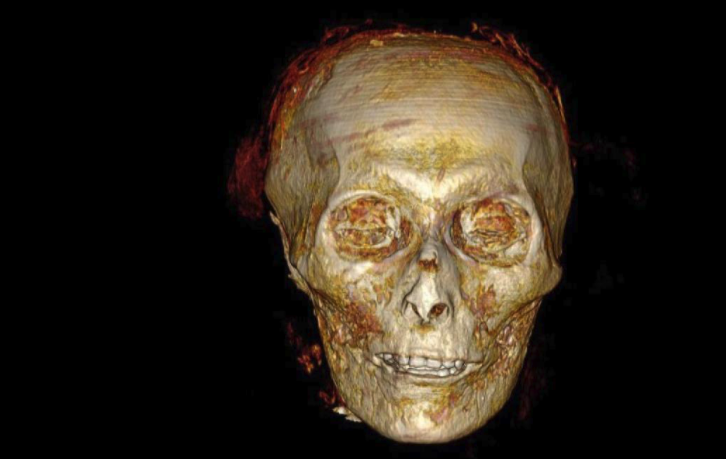Egyptian researchers digitally 'unwrap' mummy for first time

Egyptian researchers have been able to study the details of a mummified body by using for the first time a new technique that allows them to digitally "unwrap" the mummy.
Archaeologists used computer tomography (CT) to scan the mummy of King Amenhotep I, who ruled between c. 1525 to 1504 BC and whose coffin was found in the Deir el-Bahari excavation site 140 years ago.
Researchers and archaeologists refrained from opening Amenhotep 1 so as to preserve his intricate burial face mask and bandages.
The research was led by Sahar Saleem, a professor of radiology at Cairo University, and Egyptologist Zahi Awass, a former antiquities minister.
Saleem, who is the lead author of the study published in the Frontiers in Medicine medical journal, said the CT scans showed that King Amenhotep I was most likely 35 years old when he died.
New MEE newsletter: Jerusalem Dispatch
Sign up to get the latest insights and analysis on Israel-Palestine, alongside Turkey Unpacked and other MEE newsletters
Using the CT scans, researchers were able to construct a 3-D image of Amenhotep, which allowed them to see a "visualization of its different component layers: the head mask, the wrapping bandages, and the mummy".
"The digital unwrapping of the mummy by peeling off virtual layers exposed the exterior and interior of the mummy and allowed us to study it in detail," the study said.
Commenting on her findings, Saleem told PA Media that the CT scans showed that Amenhotep I resembled his father and uncovered details about his appearance and height.
"He was approximately 169cm [5ft 6in] tall, circumcised, and had good teeth. Within his wrappings, he wore 30 amulets and a unique golden girdle with gold beads," said Saleem.
"Amenhotep I seems to have physically resembled his father: he had a narrow chin, a small narrow nose, curly hair, and mildly protruding upper teeth."
'The digital unwrapping of the mummy by peeling off virtual layers exposed the exterior and interior of the mummy and allowed us to study it in detail'
- Study into Amenhotep I's mummy
Amenhotep I was the second king of the 18th Dynasty. Researchers also concluded that he was "lovingly restored" by priests from the 21st Dynasty after he was damaged by grave robbers. This included fixing Amenhotep's "detached head" and other detached limbs.
Analysis from the scans showed that Amenhotep I was the first pharaoh to have his forearms folded across his chest when buried and the last not to have had his brain removed from the skull.
Saleem, however, did not find any wounds or indications of disease to determine what caused Amenhotep I's death.
The CT scan did show, however, multiple postmortem injuries on Amenhotep I's neck and limbs, common places where jewelry would have been put, which Saleem suspects were most likely inflicted by grave robbers.
"The confession of thieves in the tomb robbery papyri indicates that they were after the jewels and amulets in between the wrappings and inside the bodies of the mummies," the study said.
"This explains that the postmortem injuries in the mummy of Amenhotep I targeted the neck and limbs, common places for jewelry, and hacked the abdomen wall in search of amulets inside the body cavity."
In the past, researchers have physically unwrapped and conducted dissection of mummies. However, these practices were condemned as they damaged the ancient bodies.
Middle East Eye delivers independent and unrivalled coverage and analysis of the Middle East, North Africa and beyond. To learn more about republishing this content and the associated fees, please fill out this form. More about MEE can be found here.





